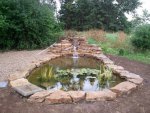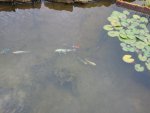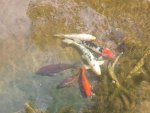Hello I put my fish in my pond about 2 -3 weeks ago. I had 3 larger goldfish 6-8 inches long all die. All of my small goldfish have been fine and my koi also appear fine. The goldfish ate fine, even better than the koi. They just strted getting lathargic, would sometimes sit just under a lily pad close to the surface and then within a day or two of acting like this they are dead. ph is 7.5-8, alk 180, hardness 600, nitrites and nitrates 0. Anything I am missing. This is a newer pond and I still don't know if it has gone thru a cycle yet. I am getting a lot of string algea in my pond right now but the water is still crystal clear. Any thoughts?
You are using an out of date browser. It may not display this or other websites correctly.
You should upgrade or use an alternative browser.
You should upgrade or use an alternative browser.
My big goldfish are dying
- Thread starter charleyd
- Start date
- Joined
- Jun 23, 2010
- Messages
- 44,413
- Reaction score
- 29,198
- Location
- Frederick, Maryland
- Showcase(s):
- 1
- Hardiness Zone
- 6b
- Country

What is your ammonia level?
HARO
Pondcrastinator
- Joined
- Jun 30, 2011
- Messages
- 5,439
- Reaction score
- 6,233
- Location
- Ontario, Canada
- Hardiness Zone
- 5b
- Country

Sounds like an ammonia problem! John
My strips dont test for ammonia. What would cause high ammonia and how do I fix it? I will get a test asap.
Wouldn't I be testing positive for nitrates or nitrites if I had an ammonia issue? Also none of the fish are at the surface for gasping for air. Even the ones that have died that were near the surface were not gasping for air. I just did a 10% water change. Should I stop feeding them for a few days?
stroppy
stroppy
i would do another water change maybe every other day untill your pond cycles .. and yes stop the feeding also if you have an air pump that would help
HARO
Pondcrastinator
- Joined
- Jun 30, 2011
- Messages
- 5,439
- Reaction score
- 6,233
- Location
- Ontario, Canada
- Hardiness Zone
- 5b
- Country

When your pond is new, ammonia builds up from fish wastes. Nitrosomonas bacteria then grow to break this down into nitrites. If you have no bacteria yet to speak of, nitrite will not show on a test, because no ammonia has been converted yet. John
I was able to get an ammonia test today. It is the Jungle strip test. My ammonia tested at 0 or ideal. I have done two 10% water changes and quit feeding them. The one larger goldfish that I have left has been lying sideways on the bottom several times (appears dead). Everytime I reach down to scoop it out to throw her away she takes off swimming. Just now when I did the test she was swimming upright. Would a %20 water change and no foor for two days eliminate the ammonia if that was the problem?
- Joined
- Jun 23, 2010
- Messages
- 44,413
- Reaction score
- 29,198
- Location
- Frederick, Maryland
- Showcase(s):
- 1
- Hardiness Zone
- 6b
- Country

Here is a good article on ammonia
http://www.ca.uky.edu/wkrec/ManagingAmmonia.pdf
http://www.practical-water-gardens.com/ammonia.htm
Why Test Pond Water for Ammonia?
The answer is simple! Ammonia is the #1 killer of aquatic life. This toxic chemical in high enough concentrations poisons the fish!
Ever wondered why a goldfish living in a goldfish bowl doesn't live very long? It is systematically poisoned by the ammonia excreted into its home through urine, waste matter and decaying fish food.
A healthy pond where the biological pond filter is working correctly will register a nil ammonia reading.
All new ponds have a bedding in period whilst colonies of Nitrosomonas and Nitrobacter beneficial bacteria start to colonize. As mentioned earlier they convert ammonia into nitrate.
These bacteria consume vast amounts of oxygen as part of this process. It is always a good idea to add additional oxygen in the form of a Fountain or Pond Aerator.
In newly established ponds, without an adequately functioning biofilter you will often find an ammonia reading of 10 parts per million (ppm) or more. This will drop as the biofilter beds in and the colonies of bacteria have built up.
As a general rule an ammonia reading of more than 0.25 ppm is an indicator of one or more of the following problems: Overfeeding, overstocking or too much decaying plant life. The increased ammonia level is not necessarily an indicator of the elevated nitrite level. The nitrite level should be tested separately on a regular basis.
A new pond filter will take between 2 to 4 weeks to establish a big enough colony of nitrifying bacteria to successfully breakdown ammonia, as it appears. Don't forget that during the initial month you must not add more than 2 fish per week. After both ammonia and nitrite levels drop to nil, more pond fish and aquatic life can be added.
If ammonia is still present after a month then: reduce feeding for one week, remove debris from the pond floor and ensure there is adequate oxygen and surface agitation. If the ammonia reading is greater than 0.50 ppm then change 25% of the pond water every 2 days until the pH reaches 0.25 ppm or less.
http://www.ca.uky.edu/wkrec/ManagingAmmonia.pdf
http://www.practical-water-gardens.com/ammonia.htm
Why Test Pond Water for Ammonia?
The answer is simple! Ammonia is the #1 killer of aquatic life. This toxic chemical in high enough concentrations poisons the fish!
Ever wondered why a goldfish living in a goldfish bowl doesn't live very long? It is systematically poisoned by the ammonia excreted into its home through urine, waste matter and decaying fish food.
A healthy pond where the biological pond filter is working correctly will register a nil ammonia reading.
All new ponds have a bedding in period whilst colonies of Nitrosomonas and Nitrobacter beneficial bacteria start to colonize. As mentioned earlier they convert ammonia into nitrate.
These bacteria consume vast amounts of oxygen as part of this process. It is always a good idea to add additional oxygen in the form of a Fountain or Pond Aerator.
In newly established ponds, without an adequately functioning biofilter you will often find an ammonia reading of 10 parts per million (ppm) or more. This will drop as the biofilter beds in and the colonies of bacteria have built up.
As a general rule an ammonia reading of more than 0.25 ppm is an indicator of one or more of the following problems: Overfeeding, overstocking or too much decaying plant life. The increased ammonia level is not necessarily an indicator of the elevated nitrite level. The nitrite level should be tested separately on a regular basis.
A new pond filter will take between 2 to 4 weeks to establish a big enough colony of nitrifying bacteria to successfully breakdown ammonia, as it appears. Don't forget that during the initial month you must not add more than 2 fish per week. After both ammonia and nitrite levels drop to nil, more pond fish and aquatic life can be added.
If ammonia is still present after a month then: reduce feeding for one week, remove debris from the pond floor and ensure there is adequate oxygen and surface agitation. If the ammonia reading is greater than 0.50 ppm then change 25% of the pond water every 2 days until the pH reaches 0.25 ppm or less.
- Joined
- Nov 11, 2010
- Messages
- 4,069
- Reaction score
- 4,013
- Location
- Chicago Area
- Hardiness Zone
- 5b
- Country

What size is your pond? it could also be lack of O2. New ponds are really tricky. I wouldn't feed at all until it was cycled. There is plenty of food in the pond already for them.
stroppy
stroppy
also how many fish do you have in there it might be too many for a new pond .. some photos of the pond might help us to help you more
I have about 5 Koi between 6" and 10". 1 Koi about 14" and 2 Koi about 3" and maybe 8-10 2-3" goldfish. The large orange goldfish died and the one that is black on top and orange on the bottom is the one laying on the botoom on its side everyday. I can't see the gill flaps moving at all and it appears dead. Everytime I try to scoop it up it takes off swimming normally then a few minutes later it is on the bottom again. I have been doing at least a 10% water change once or twice a day since starting this post and have stopped all feeding. Nitrates, nitrites and ammonia all test 0.
Attachments
- Joined
- Nov 11, 2010
- Messages
- 4,069
- Reaction score
- 4,013
- Location
- Chicago Area
- Hardiness Zone
- 5b
- Country

Hi Clint, First of all your pond looks really nice. 2nd that is a lot of fish to put in a new pond even though it is 3000 gallons. Usually it's better to start with a few fish and make sure they are healthy before adding more. It looks like it is direct sun with no shade and very little plant coverage. Even though you have a waterfall it may be dangerously low in dissolved oxygen. Lack of O2 is a big killer of fish especially in the summer. Usually larger fish have a bigger need for oxygen and are the first to feel adverse affects. I wonder what your water temps are? If they are very high then that would lower the O2 levels. I would get a bunch of airstones and start pumping air into the water.
stroppy
stroppy
yep i agree with Keith you need some air in there can you fix up some kind of shade sail for them to, if its hot there
Ask a Question
Want to reply to this thread or ask your own question?
You'll need to choose a username for the site, which only take a couple of moments. After that, you can post your question and our members will help you out.
Staff online
-
GriffinAdministrator
Forum statistics
Latest Threads
-
Leaking pond
- Started by TonyG44
-
Bittercress is the absolute worst garden weed
- Started by damian
-
Using PVC pipe from stock tank to pond
- Started by MichiganSquirrel
-
Concrete pond construction
- Started by gautprod
-
Kansas limestone okay for natural pool?
- Started by zerogravitybambi
-
Pond Sludge
- Started by Marietta Ray
-
"Natural" Remedies for Green Water
- Started by Mehitabel
-
Bog/pump clogging too frequently?
- Started by dinm
-
Norlog above ground pond.
- Started by Leolady
-
What's A Normal Water Inside Vault Reduction?
- Started by msr0459



